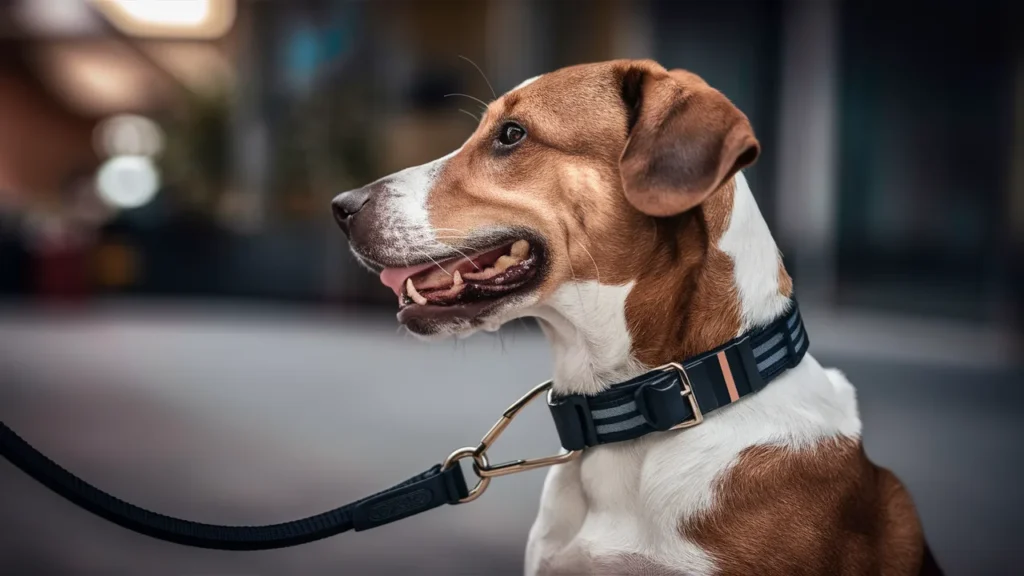Dog training collars include prong, shock, head, choke, flat, martingale, GPS, and training collars. Each collar serves a unique training purpose for dogs.
When choosing a collar, consider your dog’s needs and training goals for optimal effectiveness. Prong collars are suitable for moderate leash pullers, shock collars for advanced training, and martingale collars for dogs that pull on leads. Positive reinforcement methods using rewards are often recommended for a stronger bond between you and your furry friend.
It’s essential to select the right training collar that aligns with your training approach and your dog’s behavior. The variety of training collars available offers options to cater to different training styles and dog personalities.
Introduction To Dog Training Collars
Dog training collars come in various types and choosing the right one is important for effective training. It is recommended to use positive reinforcement training methods that use rewards to strengthen the bond between you and your furry friend. However, some collars like choke chain collars, prong or pinch collars, and shock collars are also available. It is essential to choose the collar that aligns with your training philosophy and your dog’s temperament.
Remember, every dog is different, and the collar you choose should align with your training philosophy and your dog’s personality.
Flat Collars: The Basics
Flat collars are the most basic and common type of dog training collar. They are designed to be comfortable for your dog to wear throughout the day. These collars come in a variety of materials, such as nylon, leather, or fabric, providing options for both style and durability. While flat collars are great for attaching identification tags and can be personalized, they can also have drawbacks. Some dogs may be able to slip out of them, and they can put pressure on the neck when the dog pulls. However, with proper fit and supervision, flat collars can be a practical and stylish choice for everyday use.
Choke Chains: Traditional Training
Choke chains are designed to tighten around a dog’s neck when pulled, providing a correctional tool for training. However, this functionality has raised safety concerns among some dog trainers and owners. When used improperly, choke chains can cause injury and discomfort to dogs. Therefore, it’s important to consider the safety implications of using choke chains for dog training. Proper training techniques and understanding of the risks involved are crucial for the responsible use of choke chains.

Prong Collars: Controversial Effectiveness
Prong collars, also known as pinch collars, are a controversial type of dog training collar. While some trainers find them effective in controlling strong or stubborn dogs, others argue that they can cause harm or discomfort. It’s important to carefully consider the potential impact and seek professional guidance when choosing a training collar for your canine companion.
| Types of Dog Training Collar |
|---|
| Positive reinforcement training methods—ones that use rewards—are more effective and strengthen the relationship between you and your dog. Choke chain collars, prong or pinch collars, and shock collars are other types of dog training collars that are less preferred by many dog owners and trainers. |
| Prong Collars: Controversial Effectiveness |
| Prong collars, also known as pinch collars, are designed to apply pressure to the neck area of a dog. They have metal prongs that can cause discomfort or pain when the dog pulls. These collars can be effective in training dogs that are difficult to control, but they are also controversial and should be used with caution. |
| Design Features |
| Prong collars are made of metal links with prongs on the inside. They come in different sizes, and the size of the collar should be chosen based on the size and breed of the dog. The collar should fit snugly around the dog’s neck, but not too tight. Prong collars should only be used under the guidance of a professional dog trainer. |
| When to Use with Caution |
| Prong collars should only be used as a last resort for training dogs that are difficult to control with positive reinforcement methods. They should never be used on puppies or dogs with health problems, and should be used with caution on dogs with short or sensitive necks. |
Shock Collars: High-intensity Training
| Positive reinforcement training methods | are more effective and strengthen the relationship between you and your dog. |
| Choke chain collars | can be used for training purposes. |
| Prong or pinch collars | are designed to provide gentle pressure. |
| Shock collars | utilize electronic stimulation for training. |
Best for Moderate Leash Pullers: Gentle Leader. Best for Problem Leash Pullers: Herm Sprenger Prong Collar. Best E-Collar for Family Dogs: Garmin Delta SE.
Your first option for a collar for dogs that pull on lead is a martingale (or training) collar. We use Black Dog Wear “training collars” which are the same as martingale collars.
The Halo Collar and Wireless Dog Fence is a precise tool that will communicate with your dog at exactly the right time, allowing them to seamlessly form the associations they need to keep them safely within their designated boundaries.
Martingale Collars: For Dogs That Pull
For dogs that pull on their leash, a martingale collar is a popular training collar option. These collars are designed to prevent choking and provide better control during walks. Other types of dog training collars include prong collars, shock collars, head collars, choke chains, flat collars, and GPS collars.
It’s important to choose the right type of collar for your dog’s specific needs and behavior.
| Martingale Collars: | For Dogs that Pull |
| Mechanism of Control: | Prevents dogs from slipping out of the collar. |
| Best Practices: | Ensure proper fitting for effectiveness. |
Head Collars: Gentle Leadership
There are several types of dog training collars available, each with its own unique benefits and considerations. Gentle leader head collars provide a gentle way to guide your dog without causing discomfort. When comparing head collars to other collars, it’s important to consider the training methods and acceptance levels for each type. Positive reinforcement training methods, such as using rewards, are generally more effective and strengthen the bond between you and your dog. While choke chain, prong, and shock collars are available, it’s essential to consider the most effective and humane options for your dog’s specific needs.
Harnesses: Alternative To Neck Collars
There are various types of dog training collars available, including harnesses which are an alternative to neck collars. Some types of harnesses include front-clip harnesses, back-clip harnesses, and dual-clip harnesses. When using a harness for training, it’s important to ensure a proper fit and to introduce it gradually to the dog. Harness training tips include using positive reinforcement, practicing in a low-distraction environment, and gradually increasing the duration of wear. It’s important to choose the right type of collar or harness based on the dog’s behavior and training needs. Additionally, considering the dog’s comfort and safety is crucial when selecting a training collar or harness.
Gps And Smart Collars: Technology Meets Training
Discover the various types of dog training collars, including prong collars, shock collars, head collars, choke chains, flat collars, and martingale collars. Each collar serves a specific purpose in training, ensuring effective communication and strengthening the bond between you and your furry friend.
Choose the collar that suits your dog’s needs and training goals.
| Types of Dog Training Collars |
| GPS and Smart Collars: Technology Meets Training |
| Innovative Features |
| Positive reinforcement methods are effective for dog training. |
| Collars: Choke chain, prong, and shock collars are common types. |
| Best for Leash Pullers: Gentle Leader, Herm Sprenger Prong Collar. |
| Training Collar Options: Martingale collar, e-collars, and GPS collars. |
| Cesar Millan recommends the Halo Collar for effective training. |
Cesar Millan’s Approach: Halo Collar
Cesar Millan’s approach to dog training includes the use of the Halo Collar, a precise tool that helps dogs learn boundaries effectively. This innovative collar is designed to communicate with dogs at the right moment, allowing them to form the necessary associations for their safety.
| Types of dog training collars include prong, shock, head, choke, flat, martingale, GPS, and remote collars. Positive reinforcement methods using rewards are effective for strengthening the bond with your dog. Different collars suit various training needs, such as moderate leash pulling or behavioral issues. Cesar Millan utilizes the Halo Collar, a precise tool that aids in boundary training for dogs. Comparison of training methods helps in selecting the most suitable collar for your dog’s training requirements. |
Collar Safety And Dog Wellbeing
Enhance your dog’s safety and wellbeing with various types of dog training collars like prong collars, shock collars, and martingale collars. Choose the best collar to improve training effectiveness and strengthen your bond with your furry companion.
| Types of Dog Training Collar |
|---|
| Collar Safety and Dog Wellbeing |
| Recognizing Stress Signs |
| Collar Fit and Adjustment |
When using a dog training collar, it is important to prioritize the safety and wellbeing of your furry friend. Recognizing stress signs in your dog, such as panting, drooling, or trying to escape, can help you make adjustments to the collar or training method to ensure your dog is not in distress. Proper collar fit and adjustment is also crucial to avoid discomfort or injury. It is recommended to consult with a professional dog trainer or veterinarian to determine the best type of collar for your dog’s specific needs and to receive guidance on how to properly use it for effective training. Remember, positive reinforcement methods using rewards are often the most effective and can strengthen the bond between you and your dog.
Conclusion: Making An Informed Decision
When choosing a dog training collar, it is important to consider your training goals and the comfort and safety of your dog. Positive reinforcement methods using rewards are effective and strengthen the bond between you and your dog. However, choke chain, prong, and shock collars are also available options. The Gentle Leader is suitable for moderate leash pullers, while the Herm Sprenger Prong Collar is recommended for problem leash pullers. Additionally, the Garmin Delta SE is a good choice for family dogs. Martingale collars are also effective for dogs that pull on the lead. It’s essential to select a collar that aligns with your training objectives and ensures your dog’s comfort and safety.
Frequently Asked Questions
What Are The Different Types Of Dog Training Collars?
Different types of dog training collars include choke chain, prong or pinch collars, shock collars, and martingale collars.
What Is The Most Effective Dog Training Collar?
The most effective dog training collar can vary depending on the individual dog and training needs. However, some popular options include prong collars, shock collars, head collars, choke chains, and flat collars. It is important to consider positive reinforcement training methods that use rewards and strengthen the relationship between you and your dog.
What’s The Best Collar For A Dog That Pulls?
The best collar for a dog that pulls is a martingale or training collar. These collars are designed to provide more control and prevent the dog from slipping out. They are available in various colors and designs and can be purchased from online pet stores.
Using positive reinforcement training methods is also effective in reducing leash pulling. Avoid using choke chain, prong, or shock collars as they can cause harm to the dog.
What Kind Of Collar Does Cesar Millan Use?
Cesar Millan uses the Halo Collar and Wireless Dog Fence, which is a precise tool that communicates with the dog at the right time to keep them safely within their designated boundaries. The Halo Collar is designed to seamlessly form associations that keep the dog safe.
Conclusion
There are various types of dog training collars available to suit different training needs. Positive reinforcement methods using rewards are generally considered more effective and promote a stronger bond between you and your dog. However, some trainers may opt for choke chain collars, prong collars, or shock collars for specific training purposes.
It is important to choose a collar that aligns with your training goals and techniques while prioritizing your dog’s comfort and well-being. Remember to consult with a professional trainer or veterinarian for guidance on selecting the most suitable collar for your dog.








